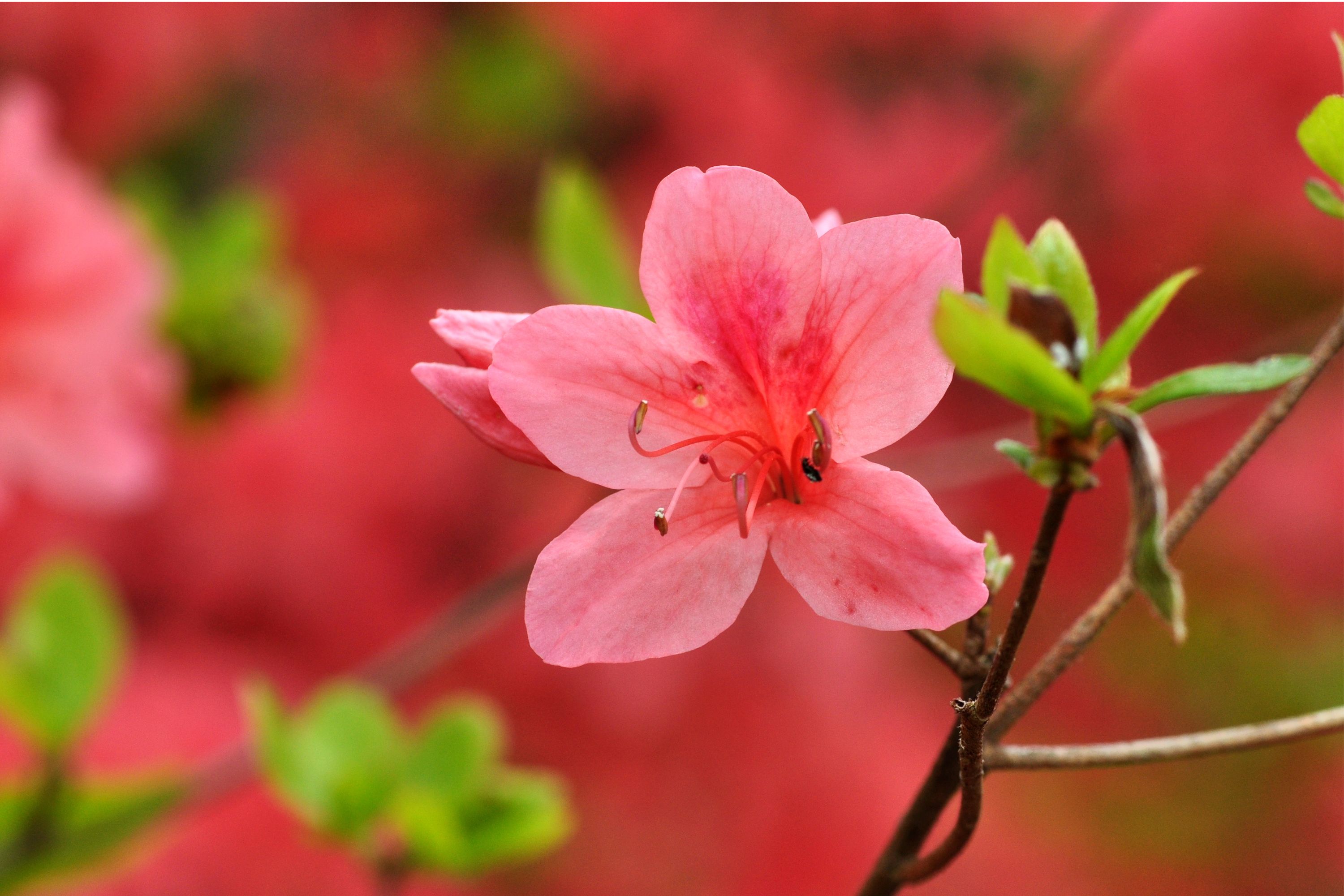Torch azalea
(Rhododendron kaempferi)

Description
Rhododendron kaempferi, commonly known as Japanese Azalea or Yama-tsutsuji, is a captivating species of flowering plant belonging to the Rhododendron genus. Renowned for its vibrant and delicate blossoms, this native Japanese azalea species has earned a special place in gardens and landscapes worldwide. In this comprehensive article, we will delve into the rich botanical and cultural aspects of Rhododendron kaempferi, exploring its characteristics, habitat, cultivation, and historical significance. Taxonomy and Nomenclature Rhododendron kaempferi was first described by the German botanist Engelbert Kaempfer in the 17th century. The genus name, Rhododendron, is derived from the Greek words "rhodos" meaning "rose" and "dendron" meaning "tree," aptly capturing the beauty and woody nature of the plants in this genus. The specific epithet, kaempferi, pays tribute to Engelbert Kaempfer, who extensively documented the flora of Japan during his travels. Description and Morphology Japanese Azalea is a deciduous shrub that typically grows between 1 and 2 meters in height, forming a dense and compact mound-shaped habit. The plant boasts slender branches and an abundance of small, elliptical leaves. These leaves are arranged alternately along the stems and display a glossy dark green color, providing an elegant backdrop to the dazzling flowers. The highlight of Rhododendron kaempferi is undoubtedly its striking blooms. The flowers, which appear in late spring or early summer, are trumpet-shaped and measure around 3 to 4 centimeters in diameter. They showcase a mesmerizing palette of colors, including various shades of pink, purple, and white. Each blossom bears five sepals and five petals, often adorned with delicate spotting or streaking, adding to the allure of the plant. Habitat and Distribution Rhododendron kaempferi is endemic to Japan, where it thrives in diverse habitats across the country. It is primarily found in mountainous regions, particularly in the Honshu and Shikoku islands. These areas provide the plant with the ideal conditions it requires, including acidic soils, moderate temperatures, and ample moisture. Cultivation and Care Due to its aesthetic appeal, Rhododendron kaempferi has gained popularity as an ornamental plant worldwide. Cultivating Japanese Azaleas can be a rewarding experience for gardeners, provided the plant's specific requirements are met. Climate: Japanese Azaleas prefer cool and temperate climates. They thrive in USDA hardiness zones 5 to 8, where winter temperatures do not dip excessively low. Light: Partial shade is ideal for Rhododendron kaempferi. It should be shielded from intense sunlight, particularly during the hottest part of the day. Filtered or dappled light is preferable to ensure proper growth and flower development. Soil: Like many other rhododendron species, Japanese Azaleas demand acidic soil with a pH range of 4.5 to 5.5. The soil should be well-draining, rich in organic matter, and consistently moist but not waterlogged. Watering: Adequate watering is crucial for Rhododendron kaempferi, especially during the growing season. The soil should be kept evenly moist, ensuring that it does not dry out completely. Mulching can help retain moisture and regulate soil temperature. Pruning: Pruning should be done selectively and minimally, Pruning: Pruning should be done selectively and minimally to maintain the natural form and shape of Rhododendron kaempferi. It is best to prune immediately after flowering to avoid removing flower buds for the following season. Dead or damaged branches can be pruned at any time of the year. Fertilization: Japanese Azaleas benefit from regular fertilization to promote healthy growth and abundant blooms. A balanced, slow-release fertilizer specifically formulated for acid-loving plants should be applied in early spring and again in early summer. Avoid excessive fertilization, as it can lead to excessive vegetative growth at the expense of flowering. Pests and Diseases: Rhododendron kaempferi is generally resistant to pests and diseases. However, it may occasionally be susceptible to azalea lace bugs, spider mites, or powdery mildew. Regular inspection of the plant and prompt treatment with organic or chemical controls, if necessary, can help maintain its health and vitality. Historical Significance and Cultural Importance Beyond its horticultural appeal, Rhododendron kaempferi holds historical and cultural significance in Japan. It is considered a symbol of elegance, grace, and beauty in Japanese culture. The plant's delicate flowers have been celebrated in traditional art forms, including paintings, pottery, and fabric design. Rhododendron kaempferi is also closely associated with Japanese festivals and tea ceremonies, where its blossoms are often incorporated as decorative elements. Conservation and Preservation While Rhododendron kaempferi is not currently classified as an endangered species, its natural habitats face ongoing environmental challenges. Deforestation, urbanization, and climate change pose threats to the survival of this species in the wild. Conserving and preserving the natural habitats of Japanese Azaleas is crucial to safeguard their biodiversity and ensure their long-term survival. Conclusion Rhododendron kaempferi, or Japanese Azalea, is a captivating flowering shrub renowned for its vibrant blossoms and cultural significance. Its graceful form, stunning flowers, and ease of cultivation make it a prized addition to gardens and landscapes. By understanding and appreciating the unique characteristics of Rhododendron kaempferi, we can further enhance our enjoyment of its enchanting beauty while contributing to its conservation and preservation for generations to come.
Taxonomic tree:







